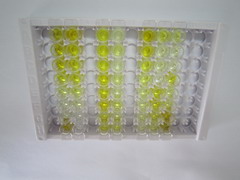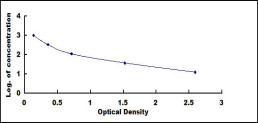Packages (Simulation)

Reagent Preparation

Image (I)
Image (II)
Certificate


ELISA Kit for Fibroblast Growth Factor 7 (FGF7)
KGF; HBGF7; Keratinocyte Growth Factor; Heparin-binding growth factor 7
- Product No.CEA636Ra
- Organism SpeciesRattus norvegicus (Rat) Same name, Different species.
- Sample TypeSerum, plasma, tissue homogenates, cell lysates, cell culture supernates and other biological fluids
- Test MethodCompetitive Inhibition
- Assay Length2h
- Detection Range12.35-1000pg/mL
- SensitivityThe minimum detectable dose of this kit is typically less than 5.37pg/mL.
- DownloadInstruction Manual
- UOM 48T96T 96T*5 96T*10 96T*100
- FOB
US$ 479
US$ 684
US$ 3078
US$ 5814
US$ 47880
For more details, please contact local distributors!
Specificity
This assay has high sensitivity and excellent specificity for detection of Fibroblast Growth Factor 7 (FGF7).
No significant cross-reactivity or interference between Fibroblast Growth Factor 7 (FGF7) and analogues was observed.
Recovery
Matrices listed below were spiked with certain level of recombinant Fibroblast Growth Factor 7 (FGF7) and the recovery rates were calculated by comparing the measured value to the expected amount of Fibroblast Growth Factor 7 (FGF7) in samples.
| Matrix | Recovery range (%) | Average(%) |
| serum(n=5) | 78-101 | 96 |
| EDTA plasma(n=5) | 86-94 | 90 |
| heparin plasma(n=5) | 98-105 | 101 |
Precision
Intra-assay Precision (Precision within an assay): 3 samples with low, middle and high level Fibroblast Growth Factor 7 (FGF7) were tested 20 times on one plate, respectively.
Inter-assay Precision (Precision between assays): 3 samples with low, middle and high level Fibroblast Growth Factor 7 (FGF7) were tested on 3 different plates, 8 replicates in each plate.
CV(%) = SD/meanX100
Intra-Assay: CV<10%
Inter-Assay: CV<12%
Linearity
The linearity of the kit was assayed by testing samples spiked with appropriate concentration of Fibroblast Growth Factor 7 (FGF7) and their serial dilutions. The results were demonstrated by the percentage of calculated concentration to the expected.
| Sample | 1:2 | 1:4 | 1:8 | 1:16 |
| serum(n=5) | 90-104% | 78-95% | 95-102% | 98-105% |
| EDTA plasma(n=5) | 84-95% | 92-101% | 96-103% | 94-103% |
| heparin plasma(n=5) | 97-105% | 94-103% | 92-105% | 80-97% |
Stability
The stability of kit is determined by the loss rate of activity. The loss rate of this kit is less than 5% within the expiration date under appropriate storage condition.
To minimize extra influence on the performance, operation procedures and lab conditions, especially room temperature, air humidity, incubator temperature should be strictly controlled. It is also strongly suggested that the whole assay is performed by the same operator from the beginning to the end.
Reagents and materials provided
| Reagents | Quantity | Reagents | Quantity |
| Pre-coated, ready to use 96-well strip plate | 1 | Plate sealer for 96 wells | 4 |
| Standard | 2 | Standard Diluent | 1×20mL |
| Detection Reagent A | 1 | Assay Diluent A | 1×12mL |
| Detection Reagent B | 1×120µL | Assay Diluent B | 1×12mL |
| Reagent Diluent | 1×300µL | Stop Solution | 1×6mL |
| TMB Substrate | 1×9mL | Instruction manual | 1 |
| Wash Buffer (30 × concentrate) | 1×20mL |
Assay procedure summary
1. Prepare all reagents, samples and standards;
2. Add 50µL standard or sample to each well.
And then add 50µL prepared Detection Reagent A immediately.
Shake and mix. Incubate 1 hour at 37°C;
3. Aspirate and wash 3 times;
4. Add 100µL prepared Detection Reagent B. Incubate 30 minutes at 37°C;
5. Aspirate and wash 5 times;
6. Add 90µL Substrate Solution. Incubate 10-20 minutes at 37°C;
7. Add 50µL Stop Solution. Read at 450 nm immediately.
GIVEAWAYS
INCREMENT SERVICES
| Magazine | Citations |
| Journal of Controlled Release | A DPP-IV-resistant glucagon-like peptide-2 dimer with enhanced activity against radiation-induced intestinal injury pubmed:28522195 |
| Inflammation | Involvements of γδT Lymphocytes in Acute and Chronic Skin Wound Repair. pubmed:28540539 |
| Catalog No. | Related products for research use of Rattus norvegicus (Rat) Organism species | Applications (RESEARCH USE ONLY!) |
| RPA636Ra01 | Recombinant Fibroblast Growth Factor 7 (FGF7) | Positive Control; Immunogen; SDS-PAGE; WB. |
| PAA636Ra01 | Polyclonal Antibody to Fibroblast Growth Factor 7 (FGF7) | Testing in progress |
| MAA636Ra21 | Monoclonal Antibody to Fibroblast Growth Factor 7 (FGF7) | WB; IHC; ICC; IP. |
| CEA636Ra | ELISA Kit for Fibroblast Growth Factor 7 (FGF7) | Enzyme-linked immunosorbent assay for Antigen Detection. |
| LMA636Ra | Multiplex Assay Kit for Fibroblast Growth Factor 7 (FGF7) ,etc. by FLIA (Flow Luminescence Immunoassay) | FLIA Kit for Antigen Detection. |















